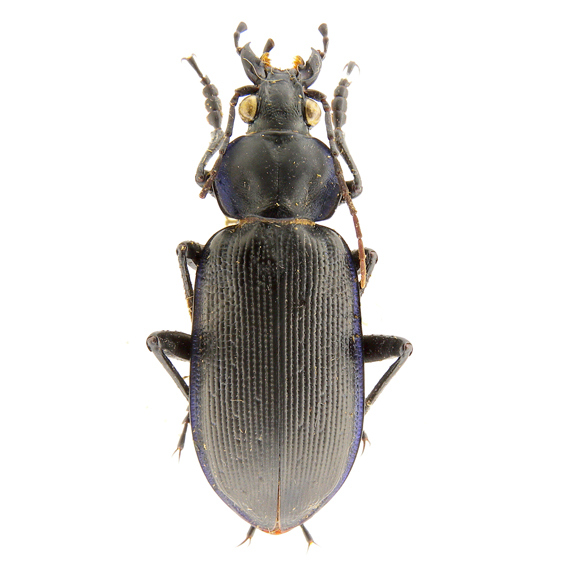Calosoma (Callitropa) externum (Say, 1823)
Carabus externus Say, 1823: 150 (described from; "Arkansa")type material and depository not stated; neotype ♀ (Little Rock Arkansas) designated by Lindroth and Freitag (1969: 331) in Museum of Comparative Zoology, Harvard University, Cambridge, Ma.
Calosoma longipenne Dejean, 1831: 568 (type locality: Amérique Boréale); holotype ♀ designated by Deuve (1978: 247) by monotypy in Muséum National d'Histoire Naturelle, Paris [examined]
Calosoma externum LeConte, 1852b: 67
Calosoma (Callitropa) externum Breuning, 1928: 116
Callitropa (s. str.) externa Lapouge, 1932: 384
Callitropa (s. str.) externum Jeannel, 1940: 213
Calosoma (Callitropa) externum Gidaspow, 1959: 273
Calosoma (Callitropa) externum Erwin, 2007: 92
Length 28-35 mm. C. externum, C. macrum and C. protractum constitute, among the other species we collect toghether in the subgenus Callitropa, a fairly homogeneous group and indeed various authors distinguish them in a separate subgenus. All of them have an elongated shape, and are winged with metaepisterna that are longer than wide.
C. externum differs from the others species of the group because its elytra are clearly striated, with intervals that are faintly scaly. The colour of the upper body is black with bluish reflections on the margins.
C. externum occupies almost the entire United States, even though it seems more common in the eastern part. It has been found occasionally in Canada (northern shores of Lake Erie), but it does not seem to be a permanent resident (Lindroth, 1961: 49).
Examined specimens and literature’s data
Canada. Ontario: Turk Point, Long Point, Point Pelee National Park (Lindroth, 1961: 49)
United States. Alabama: Tuscaloosa county (UASM); Arkansas: Little Rock (neotype, MCZ); Connecticut (Burgess & Collins, 1917: 21); Delaware: Newark (www.gbif.org); Distr of Columbia: Washington (Burgess & Collins, 1917: 21); Georgia (Burgess & Collins, 1917: 21); Illinois: Chicago (SB), Dixon Springs (http://bugguide.net/); Indiana. Marion County: Indianapolis (https://bugguide.net/); Iowa: Washington County, Decatur County (www.inaturalist.org); Kansas: Atkinson (SB), Salem, Turnpike, Wellington (www.gbif.org), Shawnee county (http://bugguide.net/), Sumner county (http://madrean.org/), Bonner Springs, Gardner, Kingman, Peck, Sedgwick County (inaturalist.org/obs); Kentucky: Christian county (UASM), Warren county (http://bugguide.net/), Metcalfe County (SB); Maryland Cove Point (http://www.covepoint-trust.org/); Massachusetts (Breuning, 1928a: 117); Michigan: Third Sister Lake (www.gbif.org); Minnesota: Olmsted co., Ramsey co. (St. Paul), Houston co. (Gandhi & al,, 2005: 922); Missouri: Vernon county (SB), St. Charles county, Stoddard county (http://bugguide.net/), Jefferson county (UASM), Maryville, Hillsboro, Tina, Andrew County (inaturalist.org/obs); Nebraska: Lancaster county (http://bugguide.net/); Nevada: Vernon county (UASM); New York (Burgess & Collins, 1917: 21); North Carolina: Durham county (http://bugguide.net/), Raleigh (SB); Ohio: Delaware county, Franklin county (www.gbif.org); Oklahoma: Stillwater (Burgess & Collins, 1917: 21), Norman, Johnston (www.gbif.org), Etowah, Mayes county, Garfield county (www.inaturalist.org); Oregon: Enterprise (www.gbif.org); Pennsylvania (Burgess & Collins, 1917: 21); South Carolina (Burgess & Collins, 1917: 21); Tennessee Great Smoky Mountains N.P. (www.gbif.org), Obion county (UASM); Texas: Palo Pinto county (http://bugguide.net/), Live Oak county (EM), Sherman (www.gbif.org), Guadalupe River State Park, Brownwood, Muenster (inaturalist.org/obs); Wisconsin: Columbia, Dane, La Crosse (Messer, 2009: 33).
Notes: Winged, often attracted to light at night. It lives in grassland and fallow land, in lowlands and midlands up to an altitude of 1000m. Occasionally, has been noted climbing trees, but probably it secures most of its food near the ground. It feeds on the grasshopper Melanopus spretus, the beetles (Melonthinae) of genus Lachnosterna, and various caterpillars as Cirphis unipunctata, Malacosoma americanum and Lymantria dispar. The adults happen to overwinter in the soil (Burgess & Collins, 1917: 22). Active individuals have been found from March to October, according to data of the examined materials, but also up to November, according to Larochelle & Larivière (2003: 177).
The description of the larva in all stages and of the pupa has been given by Burgess & Collins (1917: 23).
 (Say, 1823) Amérique Boréale (holotype of Calosoma longipenne Dejean, 1831) (coll. Muséum National d'Histoire Naturelle, Paris) |
 (Say, 1823) United States, Kansas: Atkinson, city streets, at light, 16.V.1956, JW MacReynolds |
 (Say, 1823) United States, North Carolina:Raleigh, 10.X.1948, E Thompson |